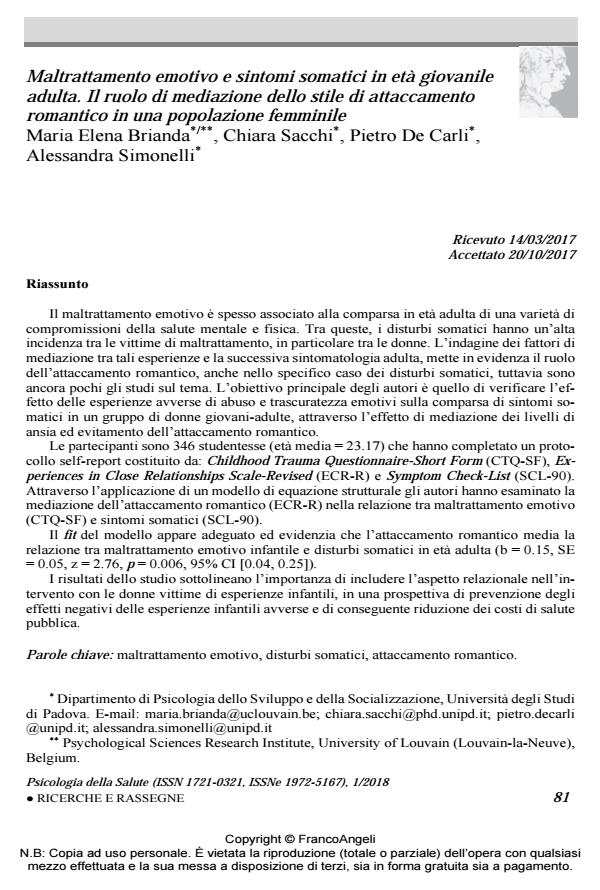Maltrattamento emotivo e sintomi somatici in età giovanile adulta. Il ruolo di mediazione dello stile di attaccamento romantico in una popolazione femminile
Titolo Rivista PSICOLOGIA DELLA SALUTE
Autori/Curatori Maria Elena Brianda, Chiara Sacchi, Pietro De Carli, Alessandra Simonelli
Anno di pubblicazione 2018 Fascicolo 2018/1
Lingua Italiano Numero pagine 21 P. 81-101 Dimensione file 330 KB
DOI 10.3280/PDS2018-001005
Il DOI è il codice a barre della proprietà intellettuale: per saperne di più
clicca qui
Qui sotto puoi vedere in anteprima la prima pagina di questo articolo.
Se questo articolo ti interessa, lo puoi acquistare (e scaricare in formato pdf) seguendo le facili indicazioni per acquistare il download credit. Acquista Download Credits per scaricare questo Articolo in formato PDF

FrancoAngeli è membro della Publishers International Linking Association, Inc (PILA)associazione indipendente e non profit per facilitare (attraverso i servizi tecnologici implementati da CrossRef.org) l’accesso degli studiosi ai contenuti digitali nelle pubblicazioni professionali e scientifiche
Il maltrattamento emotivo è spesso associato alla comparsa in età adulta di una varietà di compromissioni della salute mentale e fisica. Tra queste, i disturbi somatici hanno un’alta incidenza tra le vittime di maltrattamento, in particolare tra le donne. L’indagine dei fattori di mediazione tra tali esperienze e la successiva sintomatologia adulta, mette in evidenza il ruolo dell’attaccamento romantico, anche nello specifico caso dei disturbi somatici, tuttavia sono ancora pochi gli studi sul tema. L’obiettivo principale degli autori è quello di verificare l’effetto delle esperienze avverse di abuso e trascuratezza emotivi sulla comparsa di sintomi somatici in un gruppo di donne giovani-adulte, attraverso l’effetto di mediazione dei livelli di ansia ed evitamento dell’attaccamento romantico. Le partecipanti sono 346 studentesse (età media = 23.17) che hanno completato un pro-tocollo self-report costituito da: Childhood Trauma Questionnaire-Short Form (CTQ-SF), Experiences in Close Relationships Scale-Revised (ECR-R) e Symptom Check-List (SCL-90). Attraverso l’applicazione di un modello di equazione strutturale gli autori hanno esaminato la mediazione dell’attaccamento romantico (ECR-R) nella relazione tra maltrattamento emotivo (CTQ-SF) e sintomi somatici (SCL-90). Il fit del modello appare adeguato ed evidenzia che l’attaccamento romantico media la relazione tra maltrattamento emotivo infantile e disturbi somatici in età adulta (b = 0.15, SE = 0.05, z = 2.76, p = 0.006, 95% CI [0.04, 0.25]). I risultati dello studio sottolineano l’importanza di includere l’aspetto relazionale nell’intervento con le donne vittime di esperienze infantili, in una prospettiva di prevenzione degli effetti negativi delle esperienze infantili avverse e di conseguente riduzione dei costi di salute pubblica.
Parole chiave:Maltrattamento emotivo, disturbi somatici, attaccamento romantico
- How Does Trauma Make You Sick? The Role of Attachment in Explaining Somatic Symptoms of Survivors of Childhood Trauma Paul Samuel Greenman, Alessia Renzi, Silvia Monaco, Francesca Luciani, Michela Di Trani, in Healthcare /2024 pp.203
DOI: 10.3390/healthcare12020203
Maria Elena Brianda, Chiara Sacchi, Pietro De Carli, Alessandra Simonelli, Maltrattamento emotivo e sintomi somatici in età giovanile adulta. Il ruolo di mediazione dello stile di attaccamento romantico in una popolazione femminile in "PSICOLOGIA DELLA SALUTE" 1/2018, pp 81-101, DOI: 10.3280/PDS2018-001005